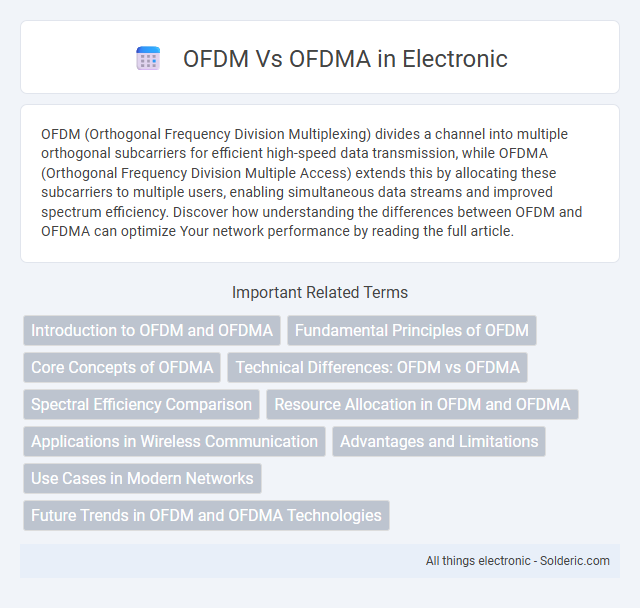OFDM (Orthogonal Frequency Division Multiplexing) divides a channel into multiple orthogonal subcarriers for efficient high-speed data transmission, while OFDMA (Orthogonal Frequency Division Multiple Access) extends this by allocating these subcarriers to multiple users, enabling simultaneous data streams and improved spectrum efficiency. Discover how understanding the differences between OFDM and OFDMA can optimize Your network performance by reading the full article.
Comparison Table
| Feature | OFDM (Orthogonal Frequency Division Multiplexing) | OFDMA (Orthogonal Frequency Division Multiple Access) |
|---|---|---|
| Definition | Modulation technique splitting a signal into multiple orthogonal subcarriers | Multi-user version of OFDM allocating subcarriers to multiple users simultaneously |
| Access Type | Single-user access | Multi-user access |
| Subcarrier Allocation | All subcarriers assigned to one user | Subcarriers divided among multiple users dynamically |
| Use Case | Broadcasting, fixed wireless communication | Cellular networks (LTE, 5G), Wi-Fi 6, multi-user scenarios |
| Efficiency | High spectral efficiency for single-user data | Improved spectral efficiency via simultaneous multi-user transmission |
| Complexity | Lower complexity in allocation and scheduling | Higher complexity due to subcarrier scheduling and resource allocation |
| Latency | Suitable for low to moderate latency applications | Optimized for low latency multi-user access |
Introduction to OFDM and OFDMA
OFDM (Orthogonal Frequency Division Multiplexing) divides a single data stream across multiple orthogonal subcarriers to enhance spectral efficiency and reduce interference in wireless communication. OFDMA (Orthogonal Frequency Division Multiple Access) extends OFDM by allocating subsets of these subcarriers to multiple users simultaneously, optimizing network resource distribution and increasing capacity. Understanding the distinction helps you choose the appropriate technology for efficient multi-user communication and improved system performance.
Fundamental Principles of OFDM
Orthogonal Frequency Division Multiplexing (OFDM) divides a wide frequency band into multiple orthogonal subcarriers, allowing simultaneous transmission without interference, which enhances spectral efficiency and resilience to multipath fading. This fundamental principle enables robust high-speed data communication by minimizing inter-symbol interference through precise subcarrier orthogonality and cyclic prefix insertion. You can leverage OFDM's core technique to optimize broadband wireless systems before comparing it directly with OFDMA's resource allocation features.
Core Concepts of OFDMA
OFDMA (Orthogonal Frequency Division Multiple Access) extends the core concept of OFDM by dividing the frequency spectrum into multiple orthogonal subcarriers, which are dynamically allocated to multiple users simultaneously, increasing spectral efficiency and reducing latency. Unlike OFDM that transmits data to a single user per time slot, OFDMA allocates subsets of subcarriers to different users, enabling multi-user access with improved resource utilization. This division of subcarriers forms the foundation of advanced wireless technologies such as 4G LTE and 5G NR, optimizing bandwidth allocation and enhancing network capacity.
Technical Differences: OFDM vs OFDMA
Orthogonal Frequency Division Multiplexing (OFDM) transmits data by dividing a single channel into multiple orthogonal subcarriers, allowing simultaneous transmission of data symbols over each subcarrier. Orthogonal Frequency Division Multiple Access (OFDMA) extends OFDM by assigning subsets of subcarriers to multiple users, enabling efficient multi-user access and dynamic resource allocation. The key technical difference lies in OFDM's single-user multiplexing, while OFDMA supports multi-user multiplexing through frequency-domain resource blocks.
Spectral Efficiency Comparison
OFDM divides the channel into multiple orthogonal subcarriers, optimizing spectral efficiency by minimizing interference and maximizing data transmission within a fixed bandwidth. OFDMA enhances this by assigning different subcarriers to multiple users simultaneously, improving spectral efficiency through dynamic resource allocation and reduced collision. Your network performance benefits significantly from OFDMA in environments requiring high user density and flexible bandwidth utilization.
Resource Allocation in OFDM and OFDMA
Resource allocation in OFDM involves dividing the available bandwidth into multiple orthogonal subcarriers, each assigned to a single user, ensuring efficient frequency division but limited multi-user scalability. OFDMA enhances this by dynamically allocating subsets of subcarriers to multiple users simultaneously, optimizing spectral efficiency and supporting flexible resource distribution to match varying user demands. Your network performance significantly improves with OFDMA's ability to allocate resources based on user requirements and channel conditions.
Applications in Wireless Communication
OFDM is widely used in wireless communication standards such as Wi-Fi, LTE, and digital TV broadcasting due to its efficient handling of multipath interference and high data rates. OFDMA extends OFDM by assigning subsets of subcarriers to multiple users simultaneously, making it ideal for multi-user environments like 5G networks and WiMAX. Your wireless systems benefit from OFDMA's improved spectrum efficiency and reduced latency, supporting diverse applications from mobile broadband to IoT connectivity.
Advantages and Limitations
OFDM (Orthogonal Frequency Division Multiplexing) offers high spectral efficiency and robustness against multipath fading, making it ideal for broadband wireless communication but is limited by its susceptibility to frequency offset and high peak-to-average power ratio (PAPR). OFDMA (Orthogonal Frequency Division Multiple Access) extends OFDM by allocating subcarriers to multiple users, enhancing system capacity and reducing latency in multi-user environments, though it introduces increased complexity in resource allocation and synchronization. The choice between OFDM and OFDMA depends on system requirements for scalability, user density, and implementation complexity.
Use Cases in Modern Networks
OFDM (Orthogonal Frequency Division Multiplexing) is widely used in single-user communication systems such as Wi-Fi and digital television broadcasting, where it efficiently handles multipath interference. OFDMA (Orthogonal Frequency Division Multiple Access) extends OFDM by allocating subcarriers to multiple users simultaneously, making it ideal for multi-user environments like 4G LTE and 5G networks. This multi-user capability enhances spectral efficiency and reduces latency in high-density urban networks and IoT deployments.
Future Trends in OFDM and OFDMA Technologies
Future trends in OFDM and OFDMA technologies emphasize enhanced spectral efficiency and reduced latency to meet 5G and beyond requirements. Advanced techniques such as dynamic subcarrier allocation, machine learning-based channel estimation, and ultra-dense network support are driving improvements in OFDMA for massive IoT connectivity. Meanwhile, OFDM continues to evolve with flexible waveform designs and improved robustness to Doppler effects, enabling better performance in high-mobility scenarios.
OFDM vs OFDMA Infographic

 solderic.com
solderic.com